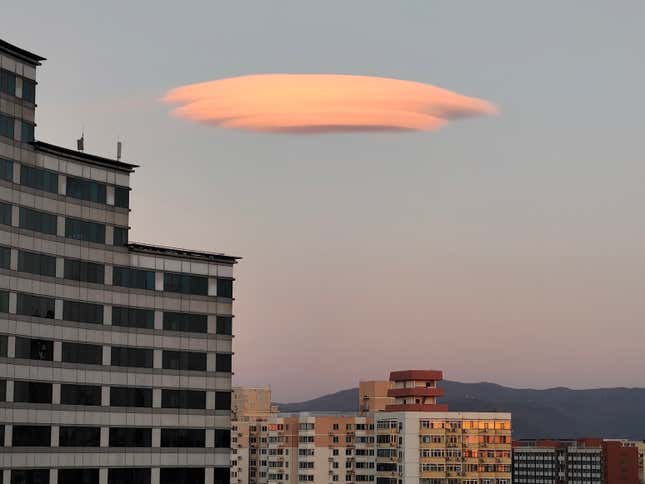It appears to be like a bit like a ship, or a stout fedora. So what the hell is that this rusty brown gossamer of an area cloud?
If we’re being completely particular, it’s the lenticular galaxy NGC 4753, which sits about 60 million light-years from Earth within the constellation Virgo. The above picture was snapped by the NASA/ESA Hubble House Telescope; the telescope views the galaxy almost edge-on, that means we’re observing it from the facet, throughout its diameter, reasonably than from above, which might reveal its full construction.
Lenticular clouds are elliptical—on Earth as they’re in heaven. Fittingly lenticular clouds typically get in comparison with, and even mistaken for, alien craft. In any case, they’re fairly alien in comparison with our regular, fluffy cumulus clouds.

Lenticular galaxies have poorly outlined spiral arms, making them look extra like rectangular blobs than the classic whirlpool swirls of spiral galaxies. In case you have been susceptible to dropping your sense of scale, NGC 4753 is a part of a cloud within the constellation Virgo that’s made up of about 100 galaxies and galaxy clusters. The universe is a giant, large place, and this lenticular galaxy is only a fuel station on one of many universe’s feeder roads.
NGC 4753 is considered the results of a galactic merger, between itself and a dwarf galaxy some 1.3 billion years in the past. The crispy brown traces of mud seen within the picture in all probability took form because of the merger, in keeping with a NASA release.
The brand new picture of the galaxy is the sharpest view of it but, relationship again to its discovery in 1784. A lot of the galaxy’s mass is locked away in a darkish matter halo, in keeping with the identical launch, that means that it can’t be imaged and its presence is barely detected by its gravitational results on seen matter. Most galaxies comprise darkish matter, because it includes about 85% of all of the universe’s matter, though some appear not to.

Darkish matter can also be at play in gravitational lensing, a phenomenon which magnifies areas of area time, permitting astronomers to picture very distant and faint objects they’d in any other case have problem with. The Hubble and Webb House Telescopes can image the same regions of space to light up objects throughout a broader vary of the electromagnetic spectrum, serving to scientists refine darkish matter fashions and traits of these objects.
The lenticular galaxy NGC 4753 would possibly problem your preconceptions about typical galactic types, but it surely’s only one instance of the variety among the many 100 galaxies and clusters within the Virgo II Cloud alone. The universe is full of a variety of galaxies; principally, in case you can think about it, the universe has in all probability bought it. With the ability to picture it’s one other matter, however on this case, the Hubble telescope had us coated.
Trending Merchandise

Cooler Master MasterBox Q300L Micro-ATX Tower with Magnetic Design Dust Filter, Transparent Acrylic Side Panel…

ASUS TUF Gaming GT301 ZAKU II Edition ATX mid-Tower Compact case with Tempered Glass Side Panel, Honeycomb Front Panel…

ASUS TUF Gaming GT501 Mid-Tower Computer Case for up to EATX Motherboards with USB 3.0 Front Panel Cases GT501/GRY/WITH…

be quiet! Pure Base 500DX Black, Mid Tower ATX case, ARGB, 3 pre-installed Pure Wings 2, BGW37, tempered glass window

ASUS ROG Strix Helios GX601 White Edition RGB Mid-Tower Computer Case for ATX/EATX Motherboards with tempered glass…










